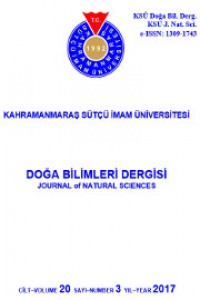Satureja hortensis Bitkisinin Uçucu Yağlarının Hordeum Vulgare L. Tohumları Üzerine Genotoksik Etkileri
Öz
Bitkilerin, geçmişten günümüze artan
biyoteknolojik yöntemler sayesinde kullanımları oldukça artmıştır. Sahip
oldukları sekonder metabolitlerin tıptan tarıma birçok alanda kullanımı hızla
yaygınlaşmaktadır. Özellikle kolay metabolize olmaları tarımsal alanlarda
sentetik kimyasallar yerine kullanımlarının önünü açmıştır. Tahıl grubundaki
bitkilere karşı fitotoksik olmayan dozlarının belirlenmesi güvenli bir şekilde
kullanımlarını sağlayacaktır. Bu amaçla; mevcut çalışmada Lamiaceae bitki
familyasına ait Satureja hortensis
türünün uçucu yağlarının biyolojik aktiviteleri belirlenmeye çalışılmıştır.
Türden elde edilen uçucu yağlar, içerik analizleri yapıldıktan sonra Hordeum vulgare L., bitkisinin çimlenen tohumlarına uygulanmış; muhtemel
genotoksik etkileri RAPD (Randomly Amplified Polymorphic DNA) PCR ile
ölçülmüştür. Dört farklı dozda (0.2, 0.4,
0.8 ve 1.6 µL mL-1) uygulanan bileşenlerin;
0.4 µL mL-1 dozunda genomik
stabiliteyi % 46.16’ya düşürdüğü diğer dozlarda ise % 50’nin üzerinde tuttuğu
gözlenmiştir. Ayrıca uçucu yağların; tüm dozlarda çimlenen arpa tohumlarının
kök uzunluklarını kontrole göre arttırdığı, gövde uzunluklarında ise kontrole
göre önemli sayılabilecek inhibisyonlara neden olduğu belirlenmiştir. Sonuç
olarak bitki bileşenlerinin literatürde geçen sentetik kimyasalların gösterdiği
etkiye benzer aktivite gösterdikleri belirlenmiştir. Hordeum vulgare L. tohumlarında fitotoksik sayılabilecek 0.4 µL mL-1
dozu dışındaki diğer dozların yabancı bitkilere karşı biyopestisit olarak
kullanılabilme potansiyeli ortaya çıkmıştır.
Anahtar Kelimeler
Kaynakça
- Agar G, Aksakal O, Bozarı S, Sunar S, Erturk FA, Yildirim N, Sevsay S 2010. Genetic variation within and among three populations of Vicia canescens L. (Fabaceae) as revealed by RAPD and FAMEs analysis. Romanian Biotechnological Letters, 15 (4):5384-5391.
Genotoxic Effects of the Essential Oil Obtained from Satureja hortensis Against to Hordeum Vulgare L. Seedlings
Öz
Plants use in many fields has
increased significantly with the increasing of biotechnological methods from past to present. Their secondary metabolites are commonly used in
many fields from medicine to agriculture. Because of their easy degradation,
they will be used as an alternative to the synthetic chemicals. Deciding their proper
non-phytotoxic doses for cereals will secure their safe usage. The present
study aimed to determine the potential biopesticide activity of plants natural
components in weeds. Thus, the essential oils obtained from Satureja hortensis species of Lamiaceae
family were subjected to analysis of volatiles and applied to Hordeum vulgare L. seedlings. Potential
genotoxic effects of these components on the seedlings were determined by RAPD
(Randomly Amplified Polymorphic DNA) PCR. The oils were applied in four
different doses (0.2, 0.4, 0.8 and 1.6 µL mL-1). Results indicated
that the third (0.4 µL mL-1) dose has changed
the genomic stability about 46.16 % and remaining doses changed the genomic stability
over the 50 %. The effects of the essential oils on root and stem length of
barley seedlings were varied. The oils have increased the root length and
inhibited stem length in all doses compared to the control. It was concluded
that plant essential oil components showed similar effects of synthetic
chemicals in the literature. With the exception of the 0.4 µL mL-1, which may be phytotoxic in Hordeum vulgare L. seeds, all doses
tested in the study have the potential to be used as bio pesticides against
weeds.
Anahtar Kelimeler
Kaynakça
- Agar G, Aksakal O, Bozarı S, Sunar S, Erturk FA, Yildirim N, Sevsay S 2010. Genetic variation within and among three populations of Vicia canescens L. (Fabaceae) as revealed by RAPD and FAMEs analysis. Romanian Biotechnological Letters, 15 (4):5384-5391.
Ayrıntılar
| Bölüm | BİYOLOJİ (Biology) |
|---|---|
| Yazarlar | |
| Yayımlanma Tarihi | 10 Mart 2017 |
| Kabul Tarihi | 12 Aralık 2016 |
| Yayımlandığı Sayı | Yıl 2017 Cilt: 20 Sayı: 3 |


